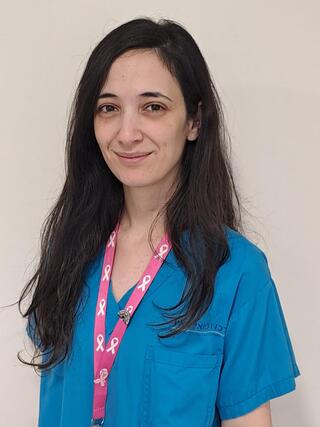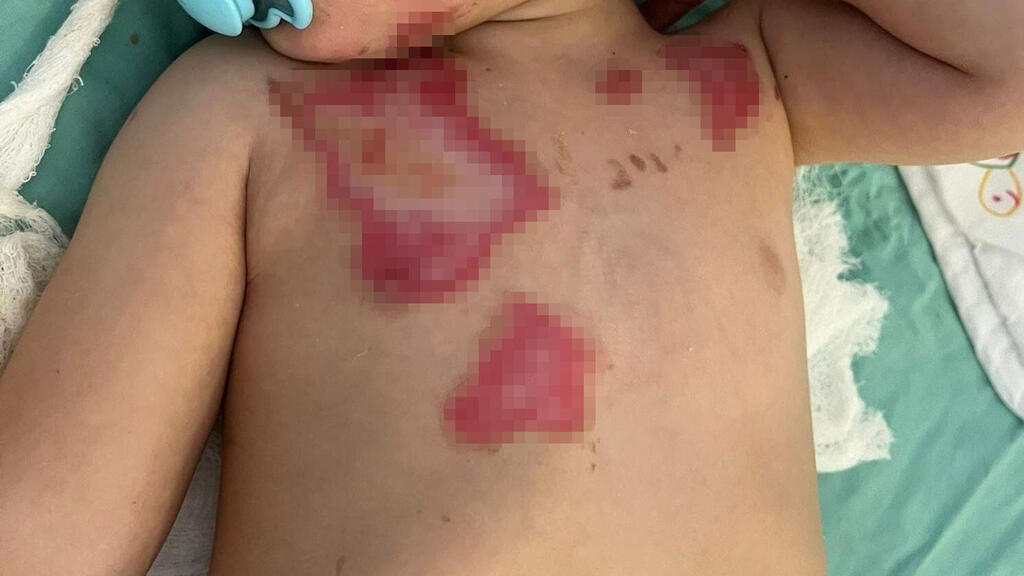"How did it happen so fast," is perhaps the most common phrase we hear from parents of children and babies who come to the ER with a burn. Burns in children happen quickly, one moment of inattention or one wrong movement, can sometimes cause great and long-term damage and guilt feelings among parents.
The parents of A, not yet a year-and-a-half old, did not imagine that their daughter would be hospitalized for nearly two weeks in the pediatric surgery department in Meir Hospital in central Israel suffering from extensive burns on her upper body and cheek.
"It was on Saturday. We are a religious family and we have a water heater that is placed on a tall kitchen table. My husband made himself a cup of tea and turned around for a second to get the sugar; in that one moment of distraction our daughter managed to pull the cup to her, which spilled over her face and chest," A's mother said.
"I heard her scream and ran to her. Her clothes were hot so I immediately realized that the tea had spilled on them as well and I immediately removed them from her. We realized that it was a serious burn, even though at first the area only looked red, and we immediately ordered an ambulance to take us to Meir Hospital. We were treated for almost two weeks by the professional staff of the plastic and pediatric surgery department, who took great care of us. If there is a particularly important message in parenting, it is that even if we try to be as careful as possible, mistakes can happen and the quick treatment that follows is just as critical and important," according to A's mother.
Risk of burns in children
When it comes to burns, children are a population at risk, for several reasons. First, identifying hot objects as dangerous and the need to avoid contact with them is an acquired skill that is not developed at all in children and babies. In addition, babies and young children are helpless and, like other populations, they cannot warn, avoid or control the thing that could cause them a burn, accidentally or on purpose. Also, due to their small body area, a burn that in an adult would cover 1%-2% of the body surface, may cover up to 10% of the body surface of a small baby, which makes the event much more complex.
One of the most common causes of burns in children and babies is a burn from a hot drink. Usually this is a cup of tea or coffee belonging to one of the parents or other family members, which is placed next to the boy or girl or in a place they can manage to reach it - for example, on the table during a meal or on a counter. In one movement, the boiling drink spills down onto the child standing below it. Next, there will be an extremely loud cry, and rightfully so since a burn does cause intense pain.
The most important thing is prevention: make sure to place the hot drink far from the edge of the table or counter. Avoid placing hot drinks near small children and babies as much as possible.
How can you minimize damage that may be caused by a burn?
1. Keep children away from things that can burn them.
2. Immediately remove clothes soaked in the hot liquid. The boiling liquid that is spilled on bare skin evaporates relatively quickly, but the liquid that is spilled on clothing is absorbed and remains at a high temperature for much longer, and continues to deepen the burn as long as it comes into contact with the skin.
3. Cool the burn area. Rinse in cold water for at least 20 minutes. Yes, it may sound excessive, but cooling the area over a long period of time slows down the progress of the burn and prevents it from deepening. Washing in cold water for a short time will indeed ease the pain, but the damage to the skin and the tissues underneath is a cumulative damage that progresses over time, so the prolonged cooling is a critical step and significantly affects the severity of the damage left by the burn.
If it is an extensive burn or in a case where washing causes discomfort to the child, after a few minutes you can soak cloths or bandages in cold water and place them on the burn area so that it is well covered, and change them every few minutes.
4. It is recommended to give the child a pain reliever. It should be administered according to the recommended dose according to weight. Remember that even if the child seems relaxed while the burn is cooling, he will most likely be in pain afterward.
5. After cooling the burn and giving a pain reliever, it's time to consider the need to contact a medical professional. If there is any doubt about its seriousness, consult with the HMO call center or come to the office closest to your home. Conditions that usually require a medical examination are burns on the face, especially involving the eye area, burns on the hands and feet, peripheral burns (which cover the entire circumference of a certain organ, such as hand, foot or fingers), burns near the genitals and the anus.
What is the effective treatment for burns?
Burn treatments are many and varied, and depend based on the depth of the burn, how much area it covers and location. In addition, the age of the child also plays a significant factor in the therapeutic decisions.
A first-degree burn is a burn that damages the epidermis layer - the outermost layer of the skin. This burn is characterized by skin redness only. This type of burn is similar to a sunburn, and usually requires cooling and over-the-counter ointments or creams that moisturize and soothe the area.
A second-degree burn is a burn that damages the dermis, the deep layer of the skin. This type of burn can manifest itself in blisters and will appear bright red-pink in color, and sometimes even white if it has hit the deeper part of the dermis layer. The treatment of a second-degree burn requires changing the dressings with prescription preparations, and sometimes will require hospitalization and even surgical treatment.
A third-degree burn is a burn that has affected the entire thickness of the skin; It will often appear yellow in color and sometimes will result in the exposure of the tissues under the skin. A third-degree burn requires professional medical treatment, hospitalization and usually also surgical treatment.
Complications and burn scars
A burn can be thought of as a large wound, damage to a superficial but sometimes extensive part of the skin exposed to bacteria. A local infection limited to the area of the burn itself will require intensive local treatment by changing dressings with antibacterial agents, and oral or intravenous antibiotic treatment.
Infection in the burn area slows down the healing of the burn and will cause less good and aesthetic scarring of the area. Infection of the burn may even lead to a systemic infection. This occurs when bacteria from the burn area moves into the bloodstream and can cause sepsis, manifested by fever, a decrease in the child's vitality all the way to apathy and lack of bowel control. Such a situation is life-threatening, therefore the appearance of any of the above symptoms after a burn is a reason to seek medical attention as soon as possible.
 ד"ר נועם קסטל
ד"ר נועם קסטלBurns tend to leave scars. These are usually second- or third-degree burns, so the scar can be an aesthetic defect, but sometimes can also cause a real functional disorder, especially if it is located in flexible areas around joints or the neck area.
The scarring depends on a number of factors, some of which are related to the burn itself - such as the depth of the burn, its location, infections and the duration of the healing process, and some of which are related to the patient; for example, skin color and a personal and genetic tendency to scarring. The treatment of scars is varied, including protection from the sun, use of silicone strips, massages, treatment with steroid injections, surgical treatment and laser treatment.
There is no doubt that a burn is one of the least pleasant events that can happen to a child as well as a parent, but with a few simple and quick actions each and every one of us can significantly reduce the potential damage and hopefully also prevent hospitalizations, complications and scars.
The author is a member of the Department of Plastic Surgery at the Meir Medical Center of Clalit Health Services
* This article does not replace the need for consultation and referral to a medical professional in the event of a burn. The article provides only preliminary instructions for initial treatment of a burn and does not replace treatment by a qualified medical professional.


